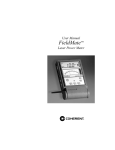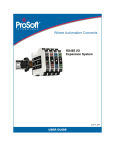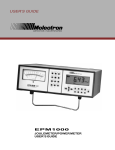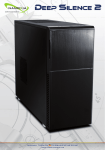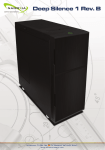Download Thermopile Support: FAQs, Troubleshooting, Care
Transcript
June 2014 Thermopile Support: FAQs, Troubleshooting, Care & Maintenance Table of Contents 1. 2. 3. 4. 5. 6. 7. 8. Introduction How long does a thermopile sensor last and how accurate does it remain over time? What are typical causes of damage on thermopile sensors? What does damage look like on thermopile sensors and how can I tell if my sensor is working properly? Examples of thermopile disks in varying conditions a. Figure 1: Healthy Thermopile Sensor with No Damage b. Figure 2: Discoloration and Scratches Caused by Moving the Sensor during Measurement c. Figure 3: Thermopile near Its Damage Threshold Caused by Moving Sensor during Measurement d. Figure 4: Thermopile Damage as the Result of Too Low of a Power Density e. Figure 5: Severe Thermopile Damage Caused by Too High of a Power Density f. Figure 6: Damaged Caused by Too High Total Power Level and Density g. Figure 7: Streaks on Thermopile Caused by Contamination h. Figure 8: Discoloration Due to Contamination i. Figure 9: kW Level Power Sensor near Its Damage Threshold j. Figure 10: Significant Damage to kW Level Power Sensors Due to Too High of a Power Density or Insufficient Water-Cooling How do I avoid damage with thermopile sensors? How can I clean a thermopile sensor if it gets dirty? How are sensors repaired when they have damage on them? Back to top Introduction Thermopile power sensors have been commonly used for laser power measurements for decades. They are a fairly robust measurement technology and can be used with lasers from relatively low power levels in the mW range up to very high power levels in the kW range. A question that comes up relatively often, is how long thermopiles last and what to look for to make sure a thermopile is in good working condition. Along with this, come questions about maintenance and cleaning of thermopiles. This document is intended to help answer some of the common questions related to those topics. Back to top www.Coherent.com I [email protected] I (800) 527-3786 I (408) 764-4983 1 June 2014 How long does a thermopile sensor last and how accurate does it remain over time? Thermopile sensors don’t have a specific life expectancy or degradation rate. As long as they are used correctly and maintained properly, thermopiles can last for years or even decades and remain in good working condition. The key is typically to just avoid damaging or contaminating the sensor surface. Thermopiles are often built out of aluminum or copper absorbing disks with a fairly strong ceramic-type coating on the surface. These sensors can typically withstand a decent amount of abuse without damaging. But there are definitely some things to watch for. If a sensor can be maintained and used without discoloration or damage to the sensor coating, these will often remain well within spec for a year or longer. We normally recommend getting thermopiles recalibrated on an annual basis to help monitor their performance and keep the sensor within spec. And as long as nothing severe happens between calibration intervals, thermopiles can have a very long lifetime with very little measurement drift. Avoiding contamination on the sensor surface is an important part of maintaining thermopiles. Any type of dirt, dust, oil, or grease that settles on this surface can cause a layer of contamination that can lead to problems. Debris or liquids that collect on the sensor surface can actually burn up when a laser beam hits the thermopile disk, which can cause increased heat on the sensor surface and can lead to damage or discoloration. So keeping thermopile sensors in a relatively clean environment can help the lifetime and accuracy of the product. Any significant changes in the color of the absorbing disk due to contaminants on it will most likely lead to changes in the absorption properties of the sensor and can lead to accuracy problems. Even having water seep into the sensor coating can cause problems with the strength of that coating. So it’s best to try and avoid contact with most liquids on the sensor surface of these products. Back to top What are the typical causes of damage on thermopile sensors? The most common cause of damage to these sensors comes from being used with too high of a power density from the laser beam. Power density has components of both the total power level and the laser beam size at the sensor surface. If the laser beam is being focused or is coming out of the end of a fiber, the beam size is very small at those locations. With small beams, the power density can be very high even if the total power from the laser is not significant. The goal with thermopile power sensors is to try and avoid positioning the sensor at a point that is near the focus of the beam. Thermopile sensors measure the total power in the laser beam and do not directly measure power density. Whether a laser beam is 5 mm in diameter or 10 mm in diameter is irrelevant to the total power measurement the thermopile is capturing. However, differences in beam size can make a large difference in the power density of that beam as it is hitting the sensor surface. It is important to understand the maximum power density specifications for the thermopile being used and to try and avoid measuring very small beam diameters. Typically the larger the beam diameter is at the sensor surface, the less chance there is of damaging the coating on the thermopile. Another source of damage could be total power. If a thermopile is rated for a maximum power level of 10 W and it is used to measure the output of a 50 W laser, the thermopile can overheat, causing internal damage to the sensor which may or may not be visible on the absorbing surface. Another possible source of damage is from objects coming in direct contact with the coating on the thermopile disk. For example, if the thermopile is being stored in a toolkit or case, it is important to ensure other tools (including the connector on the end of the sensor’s cable) do not come in contact with the absorbing disk on the thermopile. Objects www.Coherent.com I [email protected] I (800) 527-3786 I (408) 764-4983 2 June 2014 coming in contact with the absorbing surface can cause scratches in the coating, which can lead to problems with its operation and accuracy. This is also true for lasers that are being emitted out of a fiber or some type of handpiece. If the beam is exiting the laser through a fiber or a handpiece, it is best not to put the output of the laser directly up to the surface of the thermopile. This can cause physical damage to the thermopile and also to the laser output. It also increases the chances of the power density being too high at that output. When using a laser that has a fiber output, it is best to position that fiber a little ways away from the sensor surface to help protect the coating and to allow the beam to diverge out of the end of the fiber before reaching the absorbing surface. Back to top What does damage look like on thermopile sensors and how can I tell if my sensor is working properly? One of the best things that can be done to help determine if a thermopile sensor is working properly is to just do a visual inspection of the coating on the absorbing disk. This can help tell a lot about the condition of the sensor and whether or not it could be measuring accurately. The thermopile coating should be a uniform gray color. In the case of the Excimer-coated sensors, it will be a dull blue color. There should not be any black spots, bleached spots or metal showing through the coating. If any of those signs of damage are showing up on the sensor, there is a decent chance that it may not be measuring correctly. Discolorations or burn spots on the sensor coating can cause the absorption properties of the coating to change, which can cause accuracy and drift issues with thermopiles. If the coating is a uniform gray color, then there’s a good chance that at least the absorbing disk on the sensor is in good condition. If there are major burns or discolorations, that’s a good sign that the sensor may not be working within spec. Back to top Examples of different thermopiles in varying conditions The following photo gallery will illustrate how to properly diagnose various conditions as well as causes and next steps. a. b. c. d. e. f. g. h. i. j. Figure 1: Healthy thermopile sensor with no damage Figure 2: Discoloration and Scratches Caused by Moving the Sensor during Measurement Figure 3: Thermopile near Its Damage Threshold Caused by Moving Sensor during Measurement Figure 4: Thermopile Damage as the Result of Too Low of a Power Density Figure 5: Severe Thermopile Damage Caused by Too High of a Power Density Figure 6: Very Severe Damage Caused by Too High Total Power Level and Density Figure 7: Streaks on Thermopile Caused by Contamination Figure 8: Discoloration Due to Contamination Figure 9: kW Level Power Sensor near Its Damage Threshold Figure 10: Significant Damage to kW Level Power Sensors Due to Too High of a Power Density or Insufficient Water-Cooling Back to top www.Coherent.com I [email protected] I (800) 527-3786 I (408) 764-4983 3 June 2014 Figure 1: Healthy Thermopile Sensor with No Damage The absorbing disk on the sensor is a uniform flat gray color with no discolorations or burn marks on it. A sensor in this condition will typically not have any problems with the thermopile disk itself. Back to top www.Coherent.com I [email protected] I (800) 527-3786 I (408) 764-4983 4 June 2014 B A Figure 2: Discoloration and Scratches While Moving the Sensor during Measurement A. The dark discolorations that cover the entire sensor area are a collection of smaller circular marks caused by using a power density that is slightly higher than recommended while moving the beam around to different areas on the sensor disk. Slight discolorations (either slightly lighter or slightly darker marks) should not cause sensor performance issues. However, the circular marks pictured above are darker than the flat gray color of a healthy sensor surface, which indicate that the coating is starting to burn. In this specific area, the damage has not ablated or melted the coating of the sensor. However, the dark discolorations indicate the coating is starting to burn. We recommend changing the absorbing disk before major damage is caused to the sensor. B. The marks that resemble squiggly scratches are areas where the coating has been ablated. This is the result of using a tightly focused beam and moving the sensor around in the beam path during a measurement. It is evident the coating is missing due to the exposed metallic color within the marks. Back to top www.Coherent.com I [email protected] I (800) 527-3786 I (408) 764-4983 5 June 2014 B A D C Figure 3: Thermopile near Its Damage Threshold While Moving Sensor during Measurement A. The dark marks indicate the coating is beginning to burn. B. Small metallic spots surrounded by a darker ring indicate the coating has been ablated C. The slightly lighter gray spots are on the boarder of what we consider damage. This is what happens if the sensor is used very near its damage threshold. The coating discoloration typically does not cause performance problems. If you continue to see similar discoloration or if the discoloration darkens, it is necessary to reevaluate the beam size before continued use. In this particular figure we recommend replacing the disk due to the presence of both dark spots and the ablated spots. The linear pattern of marks across this sensor surface appears to indicate that the sensor was moved through the beam path while the power density was fairly high. D. Ablation on the anodized housing of the sensor does not cause any performance problems with the product, but could be another indication that the power density is too high and that the sensor has most likely been placed too close to the focal point in the beam path. Back to top www.Coherent.com I [email protected] I (800) 527-3786 I (408) 764-4983 6 June 2014 A B C Figure 4: Thermopile Damage as the Result of Too High of a Power Density This is a common example of what happens when too small of a beam size is used. The power density in these small circular spots has zapped the coating right off the sensor. A. The green color within the circular spot indicates that the sensor coating has started to melt at that spot. The presence of the color green on the sensor surface represents relatively significant damage due to a melted coating. B. Within this spot, metallic color is surrounded by a darker ring which means the coating has been ablated and there is charring around the ablation. This is caused by too high of a power density hitting the sensor surface. The sensor disk must be replaced in order to recalibrate it. www.Coherent.com I [email protected] I (800) 527-3786 I (408) 764-4983 7 June 2014 C. Small scratches are caused by something coming in physical contact with the sensor surface. For example, a tool could have hit the sensor surface while being put away, or perhaps the connector on the sensor’s cable accidentally rubbed across the sensor surface. These small scratches are usually on the very surface of the sensor and will not cause major problems unless metal can be seen within the scratches of the coating. Typically, no replacement of the thermopile disk is required unless there are a number of scratches and the scratches are deep enough to reveal metal. Back to top B C A Figure 5: Severe Thermopile Damage Caused by Too High of a Power Density www.Coherent.com I [email protected] I (800) 527-3786 I (408) 764-4983 8 June 2014 A. This is the most serious damaged spot within this figure caused by too high of a power density. The coating has been ablated and there is metal visible. The appearance of this spot would prompt a recommendation of replacing the sensor disk during repair or recalibration. Due to the spot’s central location in this particular figure, the sensor cannot be recalibrated until the disk is replaced. B. There are a number of lighter colored marks on the sensor surface that appear to have been caused by a laser beam. These spots are slight discolorations in the coating and may or may not prompt a disk replacement depending on how many there are and their location on the sensor surface. Generally, if there are one or two slightly discolored spots like this, it will not greatly affect the sensor performance and the sensor can be recalibrated to account for any slight changes in absorption due to spots like these. If there are quite a few spots, to the point where the overall absorption of the sensor is compromised, it may prompt recommending a disk replacement. C. There are a few of these small black marks on this sensor which indicate some type of burn mark. It’s possible a very small beam caused this type of burn. Or it could be that some piece of debris (maybe a piece of dirt or a drop of grease) landed on the sensor at some point. The next time a laser beam hit that spot, it may have burned the debris onto the sensor coating. Spots like this can burn in the laser beam even if the power density isn’t real high. A few small spots like this on a sensor may not warrant replacing the disk. But larger spots or large collections of these spots could prompt replacing the disk. Back to top www.Coherent.com I [email protected] I (800) 527-3786 I (408) 764-4983 9 June 2014 B A Figure 6: Very Severe Damage Caused by Too High of a Total Power Level and Density A. Example of a severely ablated and melted thermopile sensor rendered non-functional. The user most likely used too high of a total power level as well as too high of a power density, puncturing the middle of the sensor disk B. There are also a number of smaller marks around the housing and onto the sensor disk that would have been caused by a very tightly focused beam hitting the sensor. These marks did not cause the significant damage in the center of the sensor, but are a good indication that this sensor was not being used properly. These were most likely caused by a pulsed laser as the sensor was moved in and out of the beam path. Back to top www.Coherent.com I [email protected] I (800) 527-3786 I (408) 764-4983 10 June 2014 A Figure 7: Streaks on Thermopile Caused by Contamination This is an example of a sensor that has some marks on it that are most likely not affecting the performance of the product. A. The black streaks on this sensor surface were most likely caused by a small amount of grease or dirt that smeared across the sensor surface. Marks like this typically won’t cause problems with a sensor, especially since they are not in the very center of the sensor area. There is a chance that marks can burn onto the sensor disk if a laser beam hits them. However, if the marks do not get larger or worse with time, a sensor in this condition will most likely continue to work properly and may not need a disk replacement during recalibration. Back to top www.Coherent.com I [email protected] I (800) 527-3786 I (408) 764-4983 11 June 2014 A Figure 8: Discoloration Due to Contamination A. This is another case where there are some slight discolorations on the sensor surface most likely caused by small bits of contamination that got on the sensor disk. This type of discoloration is not severe enough to cause problems with the sensor’s performance. Back to top www.Coherent.com I [email protected] I (800) 527-3786 I (408) 764-4983 12 June 2014 A Figure 9: kW Level Power Sensor near Its Damage Threshold This is a case specific to kW level power sensors such as the PM1K, PM5K and LM-5000 products. A. The discoloration in this area was definitely caused by a laser beam, although it is not to the point of melting, charring, or ablation yet. Some slight discoloration with the kW level sensors is somewhat normal just given the high amount of power that these sensors absorb. Therefore, a slightly lighter or darker spot similar to what is seen here isn’t necessarily indicating that this has been damaged. This particular sensor technically has not been damaged yet. However, this discolored spot is starting to show a bit of a blue/green color to it, which means that the coating could be getting close to melting. If a spot like this shows up on the sensor, it would be recommended to take steps to reduce the power density that is being used on the sensor or to increase the water flow rate through the sensor to try and help keep it a bit cooler during measurements. www.Coherent.com I [email protected] I (800) 527-3786 I (408) 764-4983 13 June 2014 It is very important to understand the damage threshold and water-cooling requirements for kW sensor products. A water flow requirements note and kW damage threshold note have been created for these products, which should both be reviewed prior to using one of these kW level sensors. To learn more about water-cooling requirements for kW sensor products, read our applications note. Back to top C A B Figure 10: Significant Damage to kW Level Power Sensor Due to Too High of a Power Density or Insufficient Water-Cooling A. In this area a green color is present which indicates that the sensor coating has melted. In addition, there is green smoke in this damaged region. B. Black charring marks are present in this area. C. The copper thermopile disk is exposed near the center of the sensor www.Coherent.com I [email protected] I (800) 527-3786 I (408) 764-4983 14 June 2014 This sensor is an extreme case, but illustrates key things to watch for on the kW level sensors. Any time that a green melted spot, black charring, or exposed metal show up, the sensor has been significantly damaged and should not continue to be used in that condition. Damage like this can be the result of too high of a power density or from the sensor getting too hot, like what can happen without sufficient watercooling. Back to top How do I avoid damage with thermopile sensors? The primary source of damage that we typically see is simply from using too small of a beam size. Users of these products need to understand that laser power measurements do not necessarily need to be taken at the working surface or the focal point in the beam. In fact, most of the time it is ideal to avoid those spots in the beam to help avoid damage. A thermopile sensor is capable of measuring the total power in the laser beam, which can be done at a point where the beam is defocused. As long as the beam size fits within the front aperture on the thermopile sensor, the sensor should be able to take an accurate reading on it. And in most cases, the larger the beam is, the better the chances are of avoiding damage. Another source of damage is just due to overheating the sensor. This can be caused by using a sensor above its maximum rated power level, or by not having sufficient water-cooling available on water-cooled sensors. Understanding the specifications and water-cooling requirements for these products is the easiest way to avoid overheating a thermopile sensor. Back to top How can I clean a thermopile sensor if it gets dirty? Cleaning your thermopile sensors can pose a challenge simply because we recommend avoiding any liquids coming in contact with the coating on the sensor. This is due to the coating’s porous nature that allows liquids to easily seep in, causing potential corrosion or future damage. If there is dust or debris that has settled on the sensor coating, the safest cleaning method is to use clean pressurized air or compressed nitrogen air to blow the contamination off the sensor surface. The thermopile disks are fairly robust and can take quite a bit of pressure blowing onto them when trying to dislodge something that is on the surface. If needed, a soft brush, like a paint brush or a soft toothbrush can be used to try and brush any material off the sensor surface. This could be used in conjunction with pressurized air. Avoid using a cloth or anything similar that could leave lint behind. If there is oil or grease that has gotten onto the sensor that can’t be simply blown off, a small amount of optical cleaning solution (such as alcohol) can be used on the sensor. This would need to be applied using something similar to a soft brush. Again, avoid using material that will leave lint behind. Any type of optical cleaning solution should be used sparingly and dried off immediately using a heat gun or compressed air. Any residual liquid on the sensor surface is at risk of seeping into the coating. Back to top www.Coherent.com I [email protected] I (800) 527-3786 I (408) 764-4983 15 June 2014 How are sensors repaired when they have damage on them? Thermopile sensors like these cannot typically be recoated to repair damage. Once the coating is damaged or ablated, the thermopile disk usually needs to be replaced. This can get a little expensive since the thermopile disk is the only real active component inside most of these sensor products. But this is typically the only way to repair these. Sensor disks cannot be replaced in the field because the response and the calibration of the sensor will change with a disk replacement. So normally to repair these products, the thermopile will need to be sent to the factory to have a disk replacement and a recalibration. Back to top www.Coherent.com I [email protected] I (800) 527-3786 I (408) 764-4983 16

















